Following the attack on Pearl Harbor in December, 1941, Americans feared Japanese assaults on the west coast of the United States. Indeed Japanese submarines shelled targets in California and Oregon, and Japanese soldiers invaded the Aleutian Islands in Alaska for a brief time in 1942. But many Americans might be surprised to learn that during the first half of 1942, far more damage was caused by German submarines in waters off the East and Gulf coasts.
When Germany declared war on the U.S. four days after Pearl Harbor, Hitler sent a small fleet of U-boats to the East Coast. They quickly began sinking American cargo ships, many within sight of some of the nation’s largest cities. From February through May, 1942, U-boats sank 348 ships and killed an estimated 5,000 merchant seamen.
U-boat crews were surprised that the American freighters were not traveling in convoys and that cities and towns along the eastern seaboard were not blacked out. As a result, U.S. vessels were silhouetted at night by the bright city lights that made them easy targets.
In spite of the carnage taking place in U.S. waters, the Navy appeared reluctant to establish a formal system of convoys along the east coast. One reason for this was a shortage of warships. The limited number of U.S. destroyers were already helping protect convoys in the North Atlantic and fighting the Japanese in the Pacific. The U.S. Maritime Service called for coastal cities to adopt blackout conditions at night, but city fathers were reluctant to do so because blackouts were seen as bad for business.
In May, 1942, coastal centers agreed to a “dim-out” of their lights, but this was only partially effective, due to arguments over what constituted “essential lighting” for a city or town. It wasn’t until July 7 that the U.S. Government ordered blackouts for coastal cities. After that the U-boats moved on to more prolific hunting grounds in the Caribbean and Gulf of Mexico.
By effectively targeting tankers carrying oil from Texas and Louisiana ports, U-boats sank nearly a third of the existing U.S. tanker fleet. Their success not only threatened to cut off vital supplies bound for the British Isles, but also supplies of heating oil for eastern cities. The U.S. Navy was finally galvanized into action.
Using Coast Guard ships and armed trawlers on loan from the British Admiralty, Navy officials organized a “bucket brigade” convoy system. The convoys put in at ports along the Gulf and East coasts during nighttime, the period when U-boats did their greatest damage. Sinkings dropped dramatically in 1943, and most U-boats were reassigned to the North Atlantic.
U.S. industrial might slowly began to assert itself. Airplanes, warships and cargo ships began rolling off assembly lines as America’s military might steadily grew. But few in the U.S. Maritime Service would ever forget the six months when German U-boats had been the undisputed masters of American waters.





